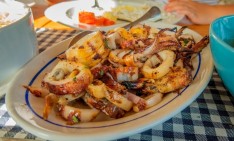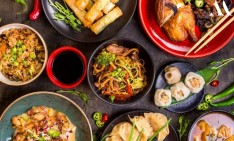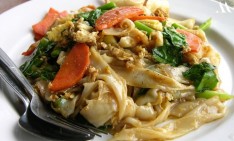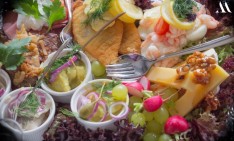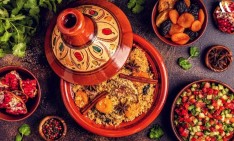The rich aroma, tastefully blending of flavours, sophisticated marrying of meats, vegetables and fruits, colourful and artfully presented Moroccan cuisine is an embodiment of intricate history and diversity of influences and a sheer sensory pleasure for a food connoisseur.
Fes and Marrakech dishes have defined Moroccan cuisine internationally. However, each region, from Riff Mountains to High Atlas and the Anti-Atlas or coastal Tan Tan, Safi to Ouarzazate and Zagora have their own dishes and versions that echo its geography, history, influences of various colonial rule and climate conditions. Rustic Berber cooking or flamboyant Spanish influence to unassuming Sahara regions palate together make a celebratory and well-balanced cuisine of Morocco.
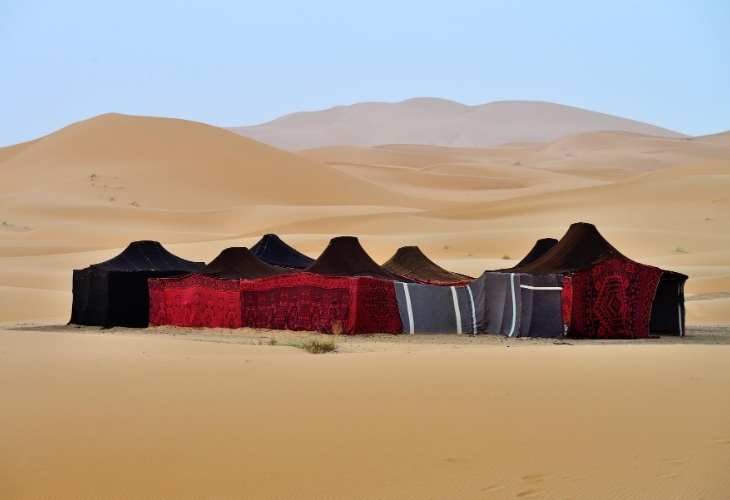
While on your journey, the local food is the first step in understanding the place and the easiest way to connect with its spirit. If you want the authentic flavour, dine in private homes or better stay in Riads, a traditional style of house that opens to a courtyard. The meals served are often family-style and feels like being an honoured guest in a private home. Riads have become quite popular in the traveller’s community for the authentic food and lavish Moroccan décor.
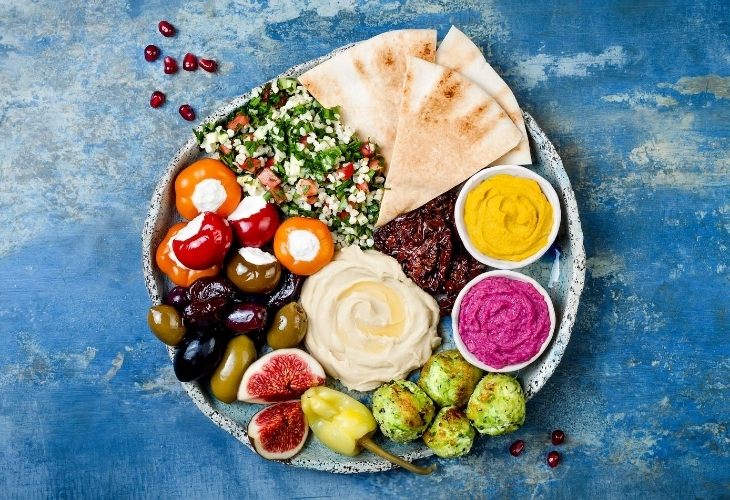
Influences |
In Morroco, you will find prominent Berber classic dishes, foremost being the tagine and couscous called sksou, trademark soups harira, and bessara served in almost all food joints from fine-dine to small street lined eatery. The dish composed of ample vegetables flavoured with a bit of lamb, beef or turkey. However. Berber cooking restricts to only a few spices in their dishes compared to the wide complex seasonings in the north region, namely Fes.
Fes expanded in 1492 with the Andalusian refugees’ settlement from Spain. After the fall of Granada, they built new cities over ruins. Their presence in the region introduced Moorish flavours from Spain with dishes made with the blending of sweet, savoury or sour and certain spice mixes. There are excellent restaurants where you can taste the seffa, sweet couscous with raisins and almonds and crispy, paper-thin sheets of pastry sprinkled with sugar, cinnamon and ground almonds.
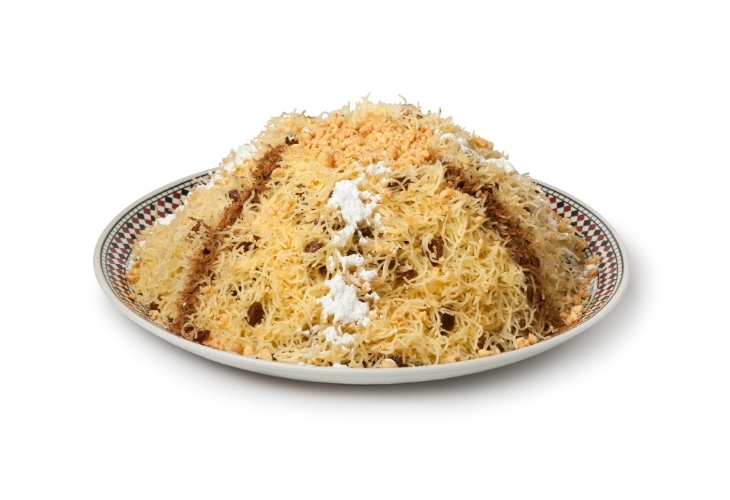
While you are in the Tangier, visit Asilah on the weekend, a quiet and common hangout place for the artists. Whitewashed seaside medina splendidly showing off its blue doors and shutters. On weekends, small restaurants are crowded for fresh fish and calamari fried in the light Andalusian style—using just flour and a bit of salt. Fresh bread along with a dipping sauce of pureed tomato accompany the main platter. Diners eat directly on paper placemats, then fold the picked-clean bones and shells into the placemats and throw them away.
Usage of tomatoes in Tangier and Tetouan is because of Andalusian heritage; you can enjoy this too in the fried fish, calamari and rice specialities showing love for sweet, smoked paprika. Fish marinated in zesty chermoula is very famous, and the marinade is for sale in souqs.
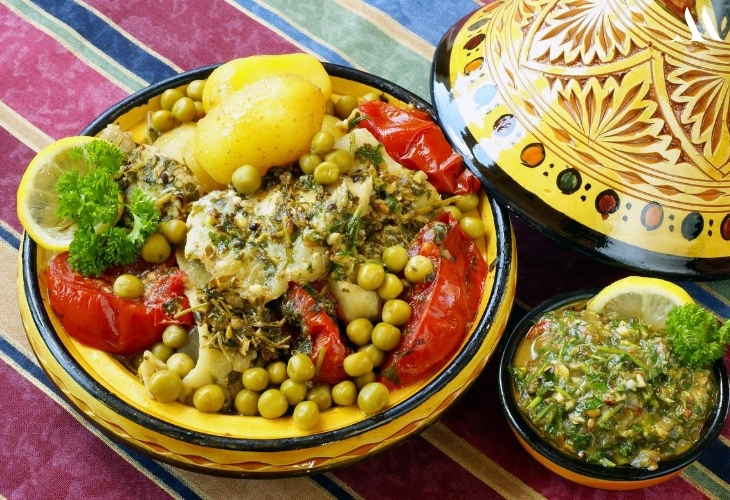
Algerian immigrants in Tetouan brought Middle Eastern and Turkish influences in cooking like grilling meat cuts and skewers of seasoned, ground kefta over charcoal. Milk-based puddings called m’halbi and many other desserts such as gazelle-horn cookies coated with sugar, m’hancha, coiled “serpentine” pastry stuffed with almond paste and Baklava.
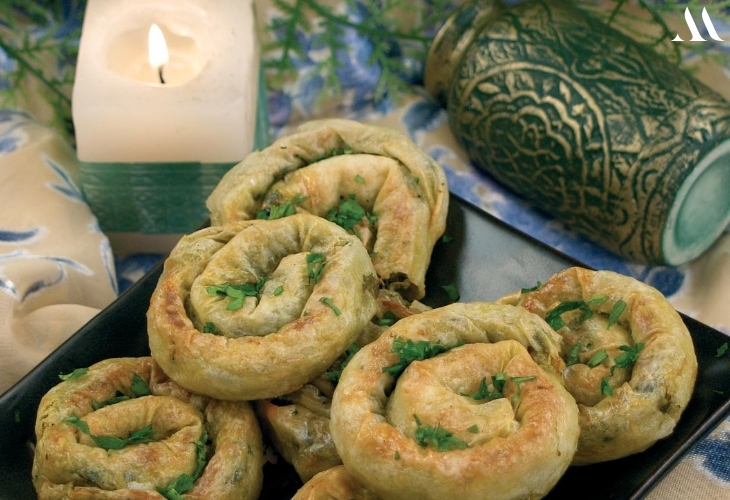
As you travel further to Chefchaouen and its pine-filled hills dense with olive, plum, almond, figs, as well as over 30 varieties of edible wild mushrooms, you will see the change in the nature of cooking. The cooking gets a rustic flavour due to its dependency on local herbs, fragrant kinds of honey, pungent cheeses from goats’ milk and whose meat Riffian Berbers stew in tagines. Beloved comfort soup bessara, made from pureed fava beans spiced with cumin and paprika, a dash of local olive oil on top, is a staple in this region.
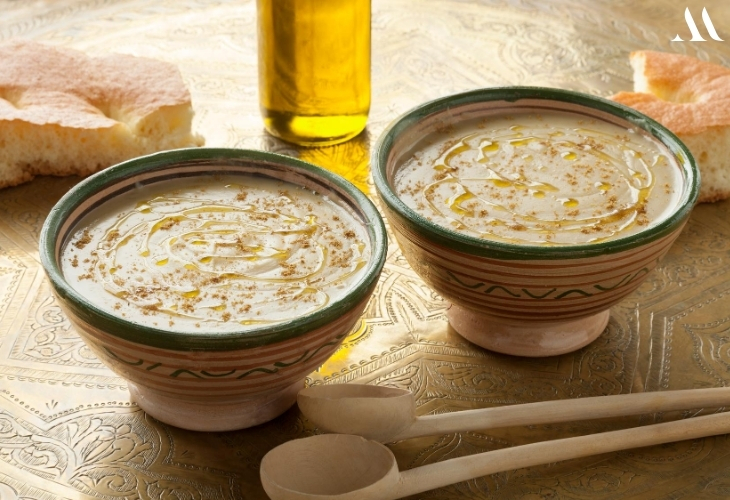
French rule in Rabat and Casablanca, along with some new towns in Fez, Meknes developed a different kind of café culture, with the sprawled terraces and wine business. Baguettes among flatbreads and morning croissants among rghayif were adapted in daily cooking.
Rabat is well known for its sweet dishes and dried fruits. Don’t miss the honeyed onion and raisin tfaya that tops tagines and couscouses and seven vegetable couscous. Although Casablanca, an hour to the south, will vouch that their version of seven vegetable couscous is best.
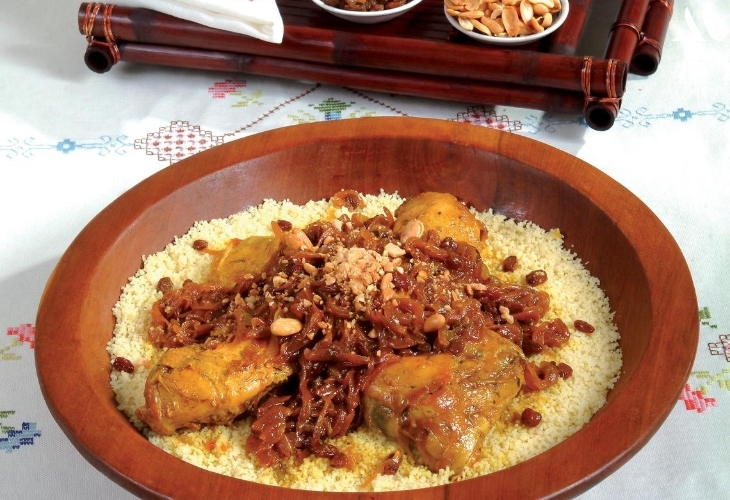
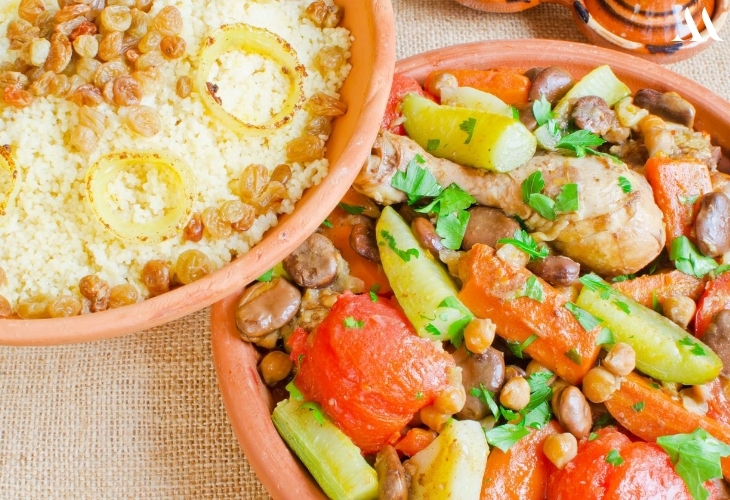
Casablanca rose to prominence because of Humphry Bogart’s movie with the same name; today, the city is not only a business capital but serves magnificent seafood in restaurants along La Corniche, the beautiful waterfront promenade.
As you travel further south-west, down the coastline, you see sardines dominate the food culture of Safi, El Jadida, Essaouira, Agadir, and Tan Tan. Largely because Morocco is the world’s largest producer and exporter of this small silvery fish, that makes it economical and abundantly available. Common preparations of sardines are seasoned ground fillet shaped balls stewed in tomato sauce-called serdine kwari and fish stewed whole over a bed of sliced potatoes, plum, tomatoes in a tagine.
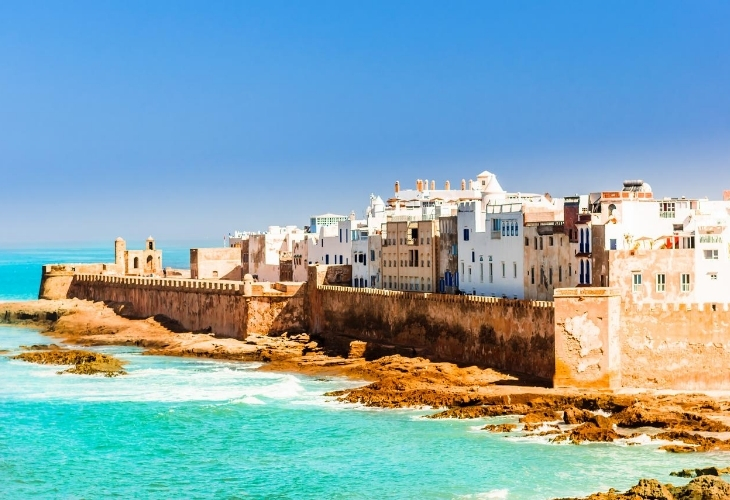
After the coastal sojourn travel towards Marrakech, the legendary Berber city founded in 1070 and capital of several formidable dynasties. Outlined with orange, lemon, and olive groves, suffused with dazzling light, it exudes a medieval feel. Marrakech is in direct competition with Fes in culinary heights.
A speciality here is tangia, seasoned beef or lamb, crushed garlic, preserved lemon, and plenty of spices, slowly cooked over several hours sealed in an earthen pot with two handles with a process called ‘steam bath’.
Djemaa el Fna, the iconic square in Marrakech, comes to life as dusk falls; this is the best place to experience Moroccan street food. Hundreds of food stalls sell everything from sandwiches with hard-boiled eggs to small grilled merguez sausages to a powerful tea called atay melouki (King Tea) made with galanga root, cardamom, aniseed, liquorice root, cinnamon, and pepper. The aroma of grilling meats—skewers of marinated lamb or spiced, ground meat known as kefta, marinated chicken fills the small streets of medinas.
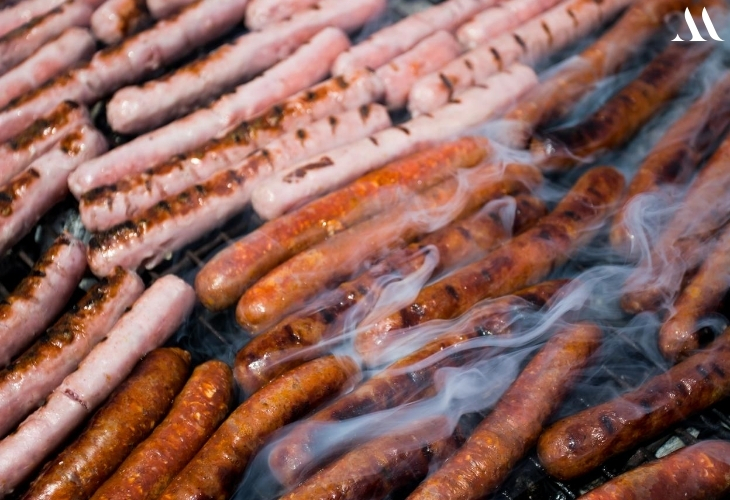
There are deep-fried potato fritters, thick fresh-fried doughnuts called sfenj, and bowls of chickpeas in broth or semolina soup dusted in cumin or caraway. It’s a heavy everyday carnival atmosphere with performers, storytellers, musicians, snake charmers, and men from the south selling ancient medicinal remedies.
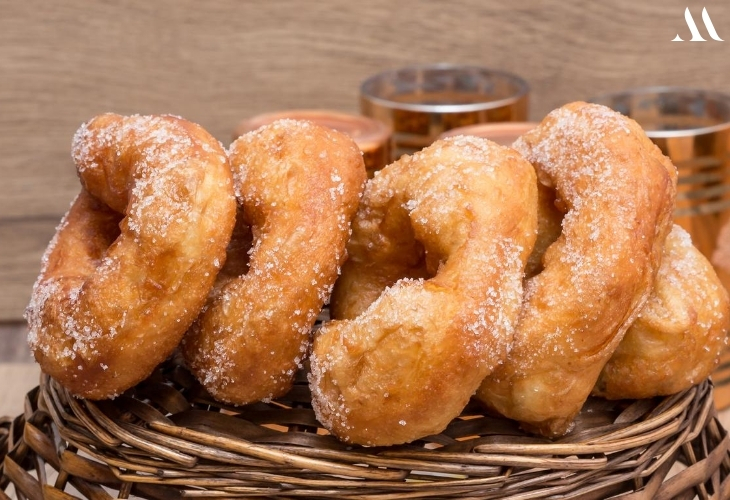
Breads |
Bread plays an inexplicable role in Moroccan cuisine, and the simplest way to appreciate the bread is - just to have bread and olives. Always constant companion with the delectable dishes, whether it's breakfast. Lunch or dinner bread is an indispensable part of a Moroccan spread. To judge the quality of bread is by its firm crust and the softness within that crust. The way it soaks the sauce from tagine and crumbles down inside your mouth is an experience to be had.
As you tour from region to region, you will notice every region has a signature type of bread, which largely depends on which colonial power occupied the region. Basic round loaves called khobz to denser ones with a blend of flours to French-style baguettes and Berber flatbreads Msemmen or Rghayef a flaky flatbread like an Indian paratha. To name a few varieties: the Harcha, a buttery bread, or Beghrir, spongy crepe.
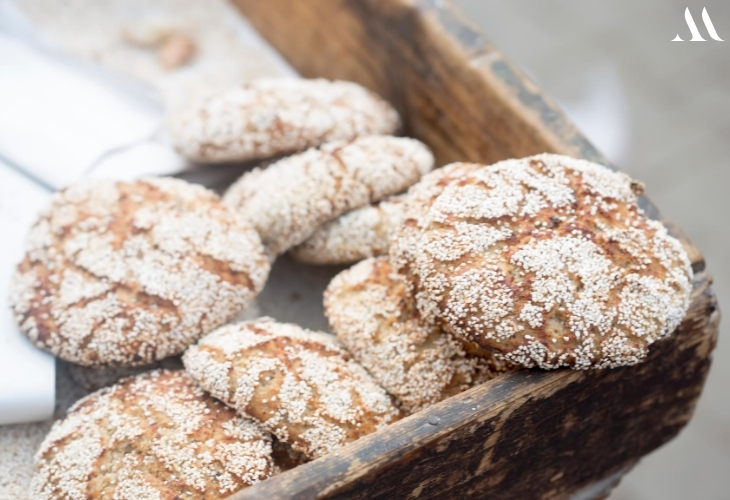
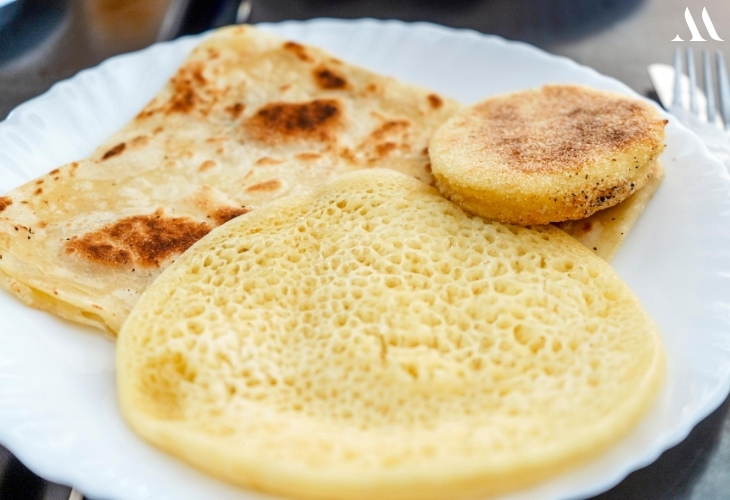
A widely practised tradition is baking bread in outdoor ovens or “Ferran”, as they are called. You will find many women carrying the proofed dough and baked bread to and from the community oven.
Savoury Pastries |
Hot, stuffed phyllo triangle shapes called briouats are delectable appetizers. The stuffing can vary from spicy meat keftas to sweet and thickened rice and milk. The more balanced one is a filling of jben - fresh unsalted cheese.
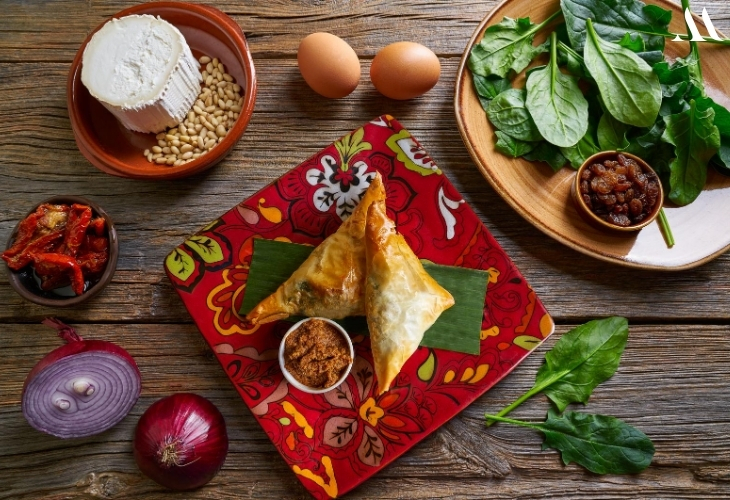
The emblematic stuffed Moroccan pastry called pastilla (also spelt b’stilla) is filled with a rich mixture of poultry, dry fruits and spice such as pigeon or chicken, eggs, almonds and cinnamon. A seafood variety; with fish, calamari and shrimp are modern, festive and very popular.
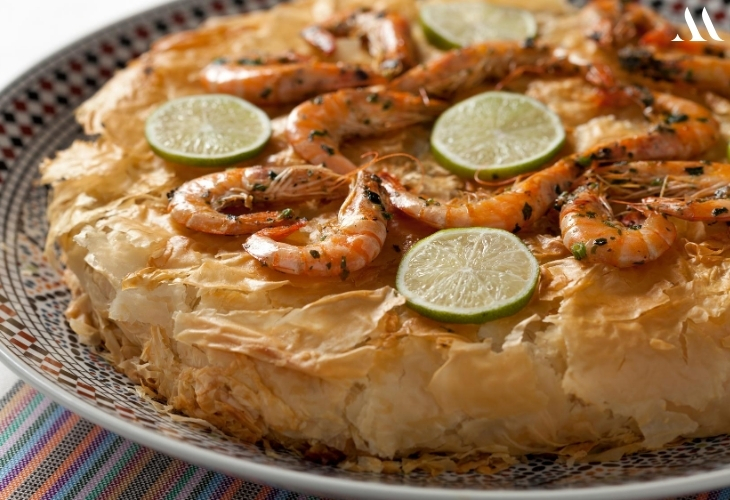
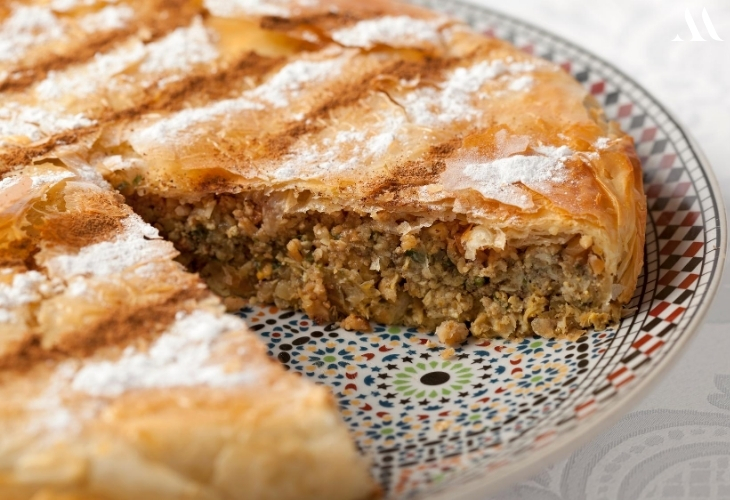
Soups |
Harira & Bessara dominate the Moroccan table. Whether it's restaurants or home-cooked, these soups are widely enjoyed from north tip to south in the desert, from the coastlines to mountains.
Harira is smooth with tomato-based puree seasoned with fresh, rich herbs. During Ramadan, it is customary that a pot filled with Harira is readily available throughout the day, and this is the first dish to break the fast.
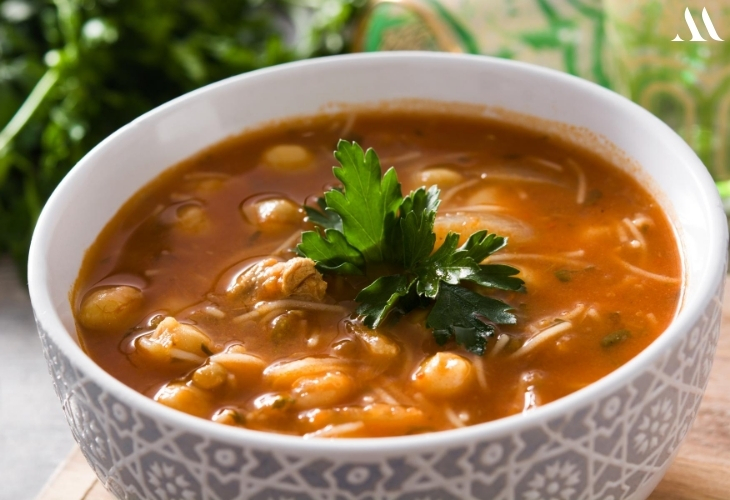
Bessara, the rustic soup of the mountains, is a lightly textured thick fava bean puree topped with local olive oil. It is best consumed with classic round slices of bread or olive, onion bread.
Meat dishes |
M’rouzia - Salty-Sweet Glazed Lamb with Almonds and Raisins
This is a symbolic dish of Eid al-Adha, one of the most important feasts of the year. To honour the sacrifice of Abraham’s son, lambs are slaughtered as an offering across the country. The sauce should be thick with a deep brown glaze at the end of cooking. Ras el hanout the spice mix is crucial, giving a complex taste of a spicy base to the honeyed sweetness.
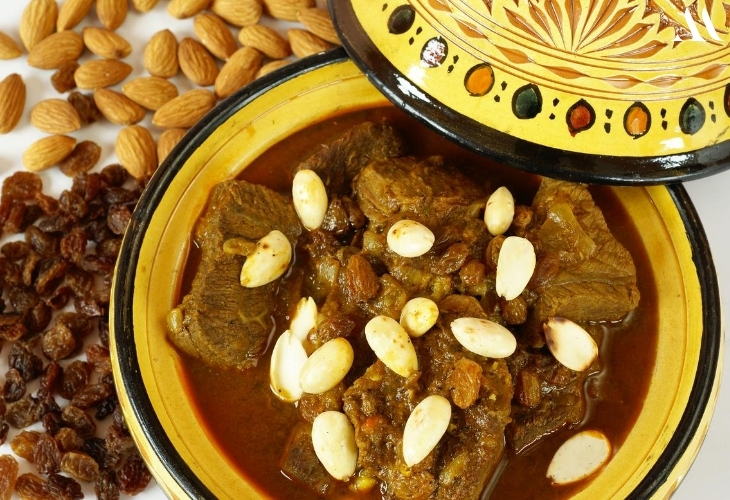
Mkila - Lamb with Garlic, Cumin, and Coriander. Mkila is a speciality of Salé, a medieval city close to Rabat. Chunks of lamb or kid are rubbed liberally in a mixture of salt, garlic paste and ground cumin and cooked until the meat starts to fall off the bone.
Tagines |
One of the country’s most important and traditional cooking methods is the tagine, a savoury stew or ragout slow-cooked in the round, earthenware pot or ceramic casserole painted or glazed to make it look attractive. It has a shallow base with a tall conical lid. The lid fits into the base’s indented rim and acts as a closed chimney. The key is the lid, which captures the steam rising from the cooking meat, poultry, or fish and enables it to condense on the lid’s walls so that moisture falls back onto the simmering food, stopping the loss of moisture or flavour. Tagines are perfect for slow cooking, whether over a charcoal filled brazier or the low to medium heat on a stove.
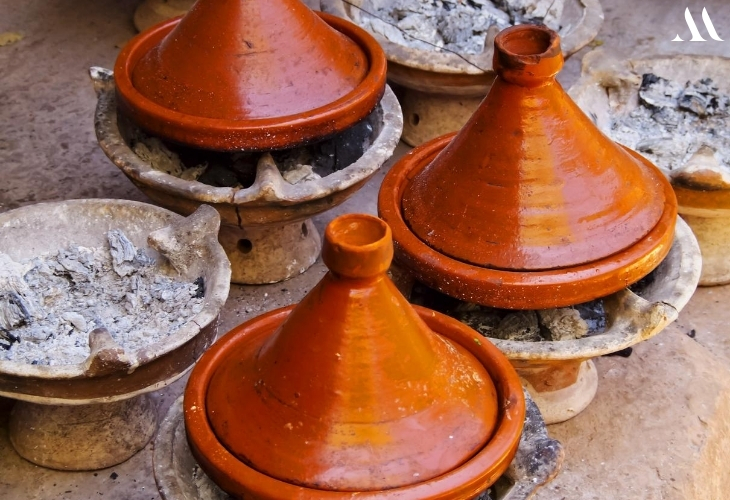
Some delicious sort after tagines are: |
Kid Tagine with Dried Figs and Thyme from the Rif Mountains
Sweet Veal Shank Tagine with Caramelized Prunes and Apricots
Veal Shank Tagine with Pears
Kefta Meatball Tagine in Tomato Sauce with Eggs
Berber Omelet Tagine - vegetables are first cooked in the tagine, and later the eggs are added over the top, seasoned with cumin and cilantro, covered with a lid till perfectly cooked. This type of simple tagine is called an omelette berbère.
Chicken Tagine with Preserved Lemons and Olives – one of the most famous dishes of Moroccan cuisine, the journey to this country shall be incomplete without it.
Chicken Tagine with Caramelized Tomato Compote, djaj m’assal - Served with plenty of bread or a bowl of plain couscous on the side.
Spicy Shrimp Tagine called shrimp al pip-pil.
Fish Tagine with Vegetables
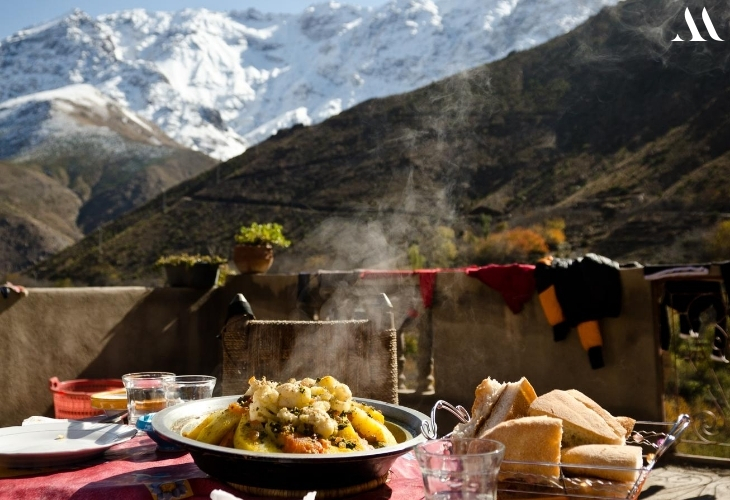
Couscous |
Couscous is to both the dish and the tiny “grains” formed from hard durum wheat or sometimes corn. Couscous grains are steamed, uncovered, in a perforated basket over a simmering, flavorful broth until light and fluffy, then arranged on a platter and covered with the stew; like the tagine, it is an ancient creation of the indigenous Berbers. Topping the mound of tender couscous might be large pieces of pumpkin flavoured with lamb, chicken and caramelized onions and raisins, along with a scattering of crunchy almonds or seven different vegetables called kuskus baydawi . Typically served alongside are glasses acidic buttermilk called lben.
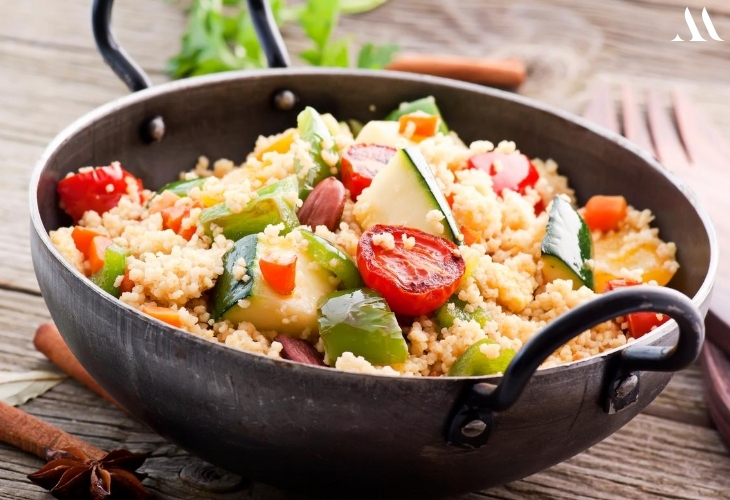
Street food must try |
Although you will find hundreds of stalls selling hundreds of street food variety. Few must try are –
Maakouda – deep-fried fritters, seasoning with cumin, fresh herbs and chilli flakes is a speciality in Fes’s ancient medina.
Babbouche – Snails in broth is a staple in Marrakech, especially in Djemaa el Fna square stalls. The broth is mostly had at the end and is considered a digestive.
Serdine Chrak – fried marinated Sardine. Popular street style way to prepare it is with the charmoula marinade smeared between butterflied sardines, which are then lightly floured and deep-fried as a pair.
More Moroccan Foods to Try |
|
| Tags ~ Moroccan dishes to try, Popular Moroccan food, History of Moroccan food, best Moroccan dishes, Berber dishes |
.png)


